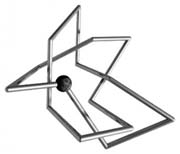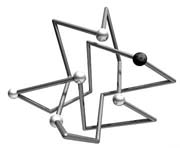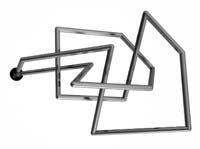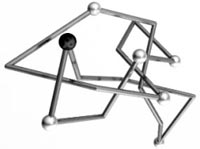KNOTTED WORD WORMS
by Mike Keith
Word Ways, 2001
Introduction
In an article in Word Ways (1993, p. 131), Ross Eckler introduced the concept of a word worm, an object defined on the three-dimensional lattice of integer-valued points. Each point in this lattice has 26 neighbors which can be reached by a single orthogonal or diagonal step. These 26 stepping directions are identified with the 26 letters of the alphabet as shown in Figure 1.
y A B C J K L R S T ^ D E F M . N U V W --|-> x G H I O P Q X Y Z | z = +1 z = 0 z = -1Figure 1. 3-D vectors defined by the 26 letters
Using this scheme, any word (or the string of successive words in a longer text) traces out a "worm" through three-dimensional space, starting from some initial point and ending, in general, at a different point.
Eckler posed the following challenge: find a word (or, failing that, a phrase or short text) that has the following properties:
(1) The worm ends at its starting point (what Eckler calls
an "Ouroboros worm"), and
(2) It ties a knot.
In this article I will discuss some aspects of this intriguing problem, including the construction of some short texts satisfying these requirements.
Observations
Although the knotting constraint is clearly the more difficult one, the requirement that the worm be a closed curve is also non-trivial. To see why, we ask: how much, on average, should we expect to move for each letter in an English text? This can be calculated by summing (over all 26 letters of the alphabet) each letter frequency multiplied by its displacement in the word-worm scheme (see Figure 1). The result is:
Average displacement ~ (0.01, 0.11, 0.16)
Note that the X coordinate is fairly balanced, but Y and Z have a significant bias in the positive direction. The worm for a random 100-word English text should, on average, end up at around (1, 11, 16) units away from its starting point, and a simple experiment with some texts verifies this. The YZ bias implies that the odds of a text worm being closed gets smaller as the length of the text increases.
One possible method for finding a knotted worm would be to simply take medium-size texts (say, all the poems of a certain author) and look for ones that are knotted (and also closed). While it does seem quite likely that such texts would yield tangled worms, it is extremely improbable that they will be closed. So this is not likely to be a fruitful approach.
For my first attempt at creating knotted text, I chose to employ a different method, which was to draw a closed and knotted path that I wanted to trace out, and then try and piece together words whose worm follows the path as closely as possible. Some deviations from the desired path are acceptable, as long as they don't occur in the vicinity of knot crossings and cause a strand to pass on the wrong side of another strand. I also imposed three additional informal constraints:
- The result should be grammatically correct.
- The knot should be fairly "clean" - that is, it should be easy to demonstrate visually that the worm is closed and knotted.
- Some form of the word KNOT should appear in the text, thus achieving the Oulipean goal of referring to the constraint in the constrained text itself.
A Knotted Text
The first knotted text I constructed, which also obeys the informal rules, has 60 letters:
A bad man outgrows, showily, his chinless Mum.
O gloomy, inwoven knottiness!
In order to visually demonstrate its knottedness, a computer program was used to build and render a 3-D model of the worm (Figure 2). The actual worm is shown on the left, with the end of each word marked by a small sphere. The drawing to the right is a slightly simplified representation. From either figure it should be easy to see that the worm forms a trefoil knot.
Figure 2. Word worm generated by "A bad man...", and a simplified drawing.
Note that spikes (like the one the grows out from the end of OUTGROWS) and local loops (like the one woven together near INWOVEN) are permitted, as long as they don't affect the knottedness of the worm. Passing a strand through one of the triangular holes near INWOVEN, in order to make a knot, would not be allowed. In other words, the knot should be unaffected by removing any local loops.
Having arrived at this text we can sacrifice some of our informal constraints and look for ways to shorten it. For example, KNOTTINESS can be replaced with a number of shorter words, such as FLUTIST. The easiest places to try shortening are away from crossings, so that we don't have to worry too much about destroying the knot. With a little tinkering we were able to shrink our mini-poem from 60 to 35 letters while still retaining its knottedness; the result, however, was not meaningful prose. This does, however, suggest two further challenges.
How low can we go?
Now that we know it is possible to construct knotted texts, the obvious question is: how short can they be? For this version of the problem we forego all grammar constraints, and consider two tasks:
(1) Use a series of one or more English words, and attempt to minimize either the number of words or the total number of letters.
(2) Use the smallest string of letters possible (not requiring it to spell real words). We refer to these as letter worms.
Consider problem #2 first. As noted by Eckler, the
nine-letter string TYDBNYRDI forms a knot, but apparently it
has not, until now, been proven minimal. It is known that the
"stick number" of the trefoil knot (minimum number
of sticks required to construct it) is six, but it is not
clear if one can argue from this fact and achieve the desired
conclusion. Instead, I wrote a computer program that
exhaustively looked for knotted 8-letter strings (but
intelligently, so that only about 20,000,000 rather than 268
combinations had to be examined), using the knot-detection
method described in the next paragraph. Just a few hours of
computation were needed to determine that none exist, and
therefore that nine is, in fact, the minimum.
How close to nine letters can we get using real words? In
order to effectively attack this problem a computer is almost
certainly needed, but picking the best strategy to use
requires some thought. (Readers uninterested in the details
may skip to the next paragraph.) We would like to have a
computer procedure that determines whether a worm is knotted,
but even better would be one that tells us which kind of knot
(of the many topologically distinct ones) it is. Several
algorithms which can do this are known (based on knot
polynomials - see reference [1] for a good
introduction), but there are a number of tradeoffs (between
execution speed, "foolproof-ness" of the method,
and other factors) to be considered. For instance, some
polynomials cannot distinguish between certain knots, but
this is acceptable if it never happens for fairly simple
knots such as we expect to encounter here. I eventually
decided to implement the Alexander polynomial, which
can distinguish between all knots up to eight crossings (and
many thereafter) and can be computed relatively easily by
calculating the determinant of a certain matrix based on the
crossings in a two-dimensional projection of the knot. The
key point, of course, is that the polynomial is invariant
under all topological deformations, and so gives the right
answer no matter how much a knot has been distorted.
I combined the computerized knot detector with a control
program that tests all single words and all pairs of words,
and set it working on my machine-readable word lists. No
single-word knots were found, thus adding substantial support
to Eckler's conjecture that no such beast exists, since we
probably examined a few hundred thousand more words than have
ever been checked before. Of course, a bigger word list might
produce one. It would especially useful to have a large
selection of words of length 9 through (say) 11. On the one
hand, we know that nine letters are required; on the other
hand, the "YZ drift" discussed above, plus the fact
that there are fewer long words, means that long words are
unlikely to yield a solution.
The results for two-word pairs were much more interesting. Using a small word list containing mostly common words (such as those found in the Pocket Mirriam-Webster) a knotted worm was found (GULF WOMANLY) having only 11 letters - just two away from the theoretical minimum. This is shown in Figure 3a. (Note, by the way, that in these figures the x,y,z axes do not always point in the same direction. This is because each figure has been rotated in 3D so as to make the knot easy to visualize.)
(a) GULF WOMANLY (b) YO ELUVIAL
Figure 3. Some small two-word knotted worms.
The next shortest pairs that the program found (using this word list) were AVOIDS WOEFULLY and BUZZED CROSSING, both 14 letters. Not surprisingly, all the knots are trefoils.
The result using our largest word list was even more startling: a nine-letter solution was found! Figure 3b shows this remarkable word pair (both bold-face entries in Webster's Third Unabridged) that ties a trefoil knot using the smallest possible number of letters. As a bonus, it is also an AEIOU string, containing each vowel exactly once. The way the word ELUVIAL twists around makes it particularly amenable to forming knots. It can also be combined with WOO to make a 10-letter knot, or KOZO to make an 11-letter one. No other nine-letter, two-word solutions were found.
Since the minimum number of letters is nine, another interesting challenge is to try and make a knot with three three-letter words. Two such strings were found: CRY IDS WOE (the only 3-3-3 knotted worm in the Official Scrabble Player's Dictionary) and DIN ROE LYS.
Other Knots
The three puzzles discussed so far (construct a small
grammatically-correct text, or a short series of words, or a
minimal series of letters) can also be considered for each
topologically-distinct knot. Since there are an infinite
number of different knots, of ever increasing complexity,
this opens a vast area for further exploration.
Note that any type of knot can be tied using a (perhaps long)
series of English words. One way to do this is to pick 26
different words that cause an overall displacement equal to
one of the 26 orthogonal or diagonal steps in the 3D lattice.
Now construct the desired knot using a straight-line path
through the lattice (like a word worm), and then stretch all
the lines by a factor of n. Each "stick"
in the magnified knot can be traced out using n
copies of the appropriate word. Although the path spelled out
will deviate slightly from the desired path, if n is
chosen to be large enough no damaging deviations (that would
destroy the knot) will occur. This is because each word
deviates from the path by a constant, and therefore by
increasing n the relative deviation (compared to the stick
length, n) can be made as small as desired. This
suffices to make any knot using a series of words; with a bit
more effort it should always be possible to make sentences or
poems as well, utilizing the fact that a number of words are
available for each direction.
Having already discussed the trefoil, Figure 4 shows our best
efforts at letter worms and word worms for the next three
knots. Again, all words are bold-face entries in Web3. It is
not known if these solutions are minimal, so readers are
invited to attempt to find shorter ones.
Knot 41 (Figure-eight):
ZUQEJLHXTAE TWI ORGIES SYN BOA
Knot 51 (Solomon's Seal):
MCWNGYMBSLHYQDR PAUSE FLY FOU PAT A PITY
Knot 52
ZUQFKJOQTPOATAE O IT I BUY JANN QOPH TARS
Figure 4. Small letter worms and word worms for the knots 41, 51, and 52.
The worms in the right column of Figure 4 are optimized for the fewest number of letters. Trying to use as few words as possible gives five-word solutions for the five-crossing knots:
51: PAUSE FLY FOU PAT ANIMOSITY
52: OR WILGA OYEZ TEASY DIETS
Table 1 summarizes the current state of knowledge
regarding knotted word worms. Each knot's crossing number
(minimum number of crossings needed in any 2-D drawing) and
stick number are shown, as well as its corresponding word
worm properties. Values enclosed in parentheses are our best
efforts, not known to be minimal. Observe that all three
values (15, 19, and 5) are the same for the two five-crossing
knots. There is no reason to believe this will always be the
case, but it does seem reasonable to conjecture that knots
with the same crossing number will have similar word worm
parameters.
Knot 31 41 51 52 Crossing number 3 4 5 5 Stick number 6 7 8 8 Length of smallest
letter worm9 (11) (15) (15) Smallest number of letters
in series-of-words worm9 (15) (19) (19) Fewest words in
series-of-words worm(2) (4) (5) (5) Table 1. Some knotted word worm results.
References
[1] Adams, Colin C., The Knot Book, W. H. Freeman & Co., 1994.








